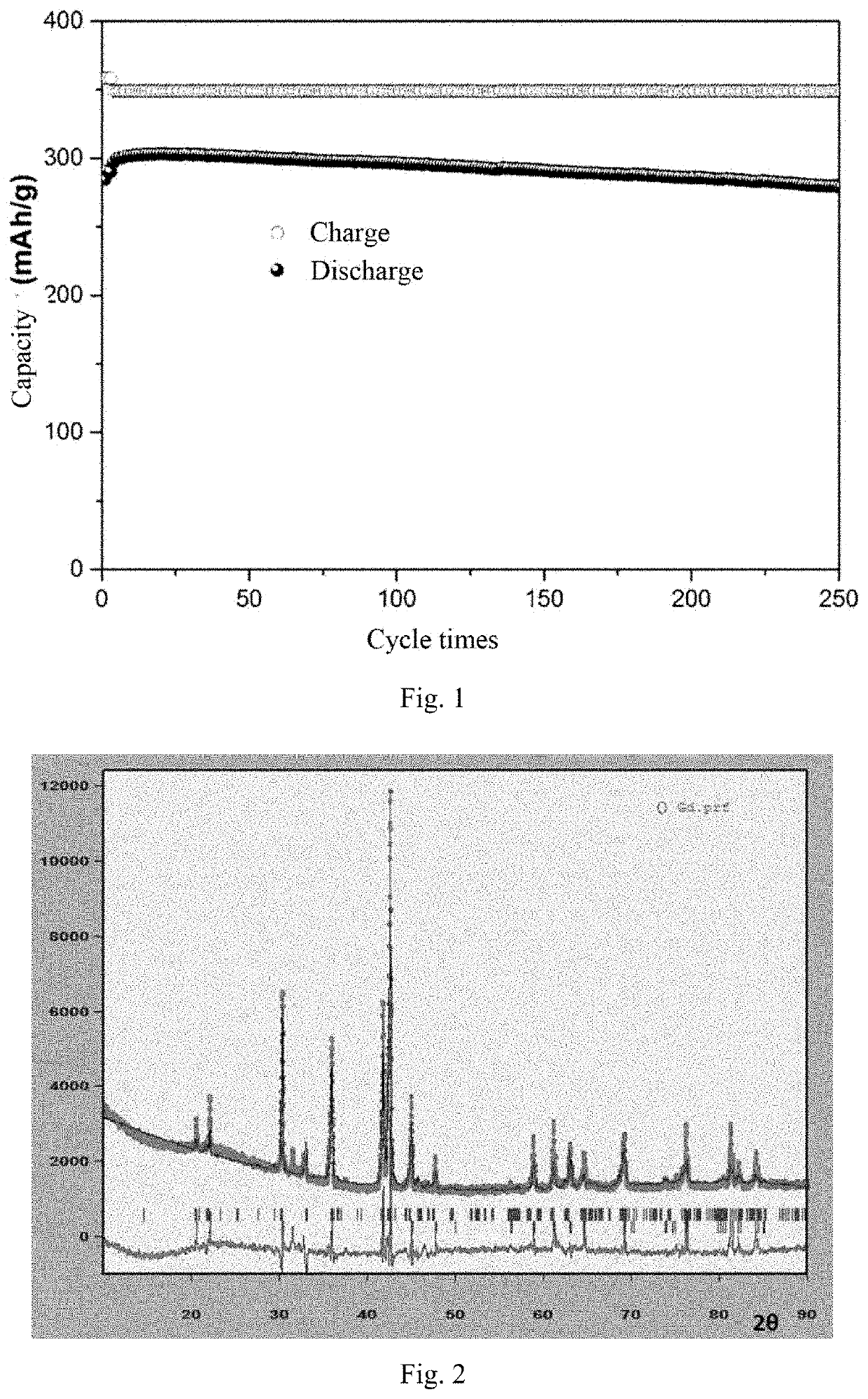AB5-BASED HYDROGEN STORAGE ALLOY, ELECTRODE FOR Ni-MH BATTERY, SECONDARY BATTERY, AND PREPARATION METHOD OF HYDROGEN STORAGE ALLOY
a hydrogen storage alloy and a technology for secondary batteries, which are applied in the field of batteries and battery hydrogen storage materials, can solve the problems of poor high-rate discharge performance, high cost, and difficult initial activation, and achieve the effects of shortened cycle life, corrosion resistance and cycle life improvement, and improved nucleation rate of solidification process
- Summary
- Abstract
- Description
- Claims
- Application Information
AI Technical Summary
Benefits of technology
Problems solved by technology
Method used
Image
Examples
example 1
[0028]A hydrogen storage alloy La(3.0˜3.2)xCexZrySm(1−(4.0˜4.2)x−y)NizCouMnvAlw was set to contain La 7.79 at %, Ce 2.49 at %, Zr 0.46 at %, Sin 5.39 at %, Ni 71.60 at %, Co 2.63 at %, Mn 4.08 at %, and Al 5.64 at %, wherein the elements La, Ce, Zr and Sin were A-side elements, and the elements Ni, Co, Mn and Al were B-side elements, thereby forming an AB5 hydrogen storage alloy La0.50Ce0.16Sm0.34Zr0.03Ni4.57Co0.17Mn0.26Al0.36. The atomic ratio of La to Ce was fixed at about 3.1 to satisfy the requirements of the overcharge performance of the electrode material; A side elements are largely substituted by samarium (Sin) element, that is, the atomic ratio of Sin on the A side was about 33%, so as to solve the problem of shortened cycle life caused by the small amount of cobalt (Co) atoms. The equilibrium pressure was adjusted by the change in the ratio of Sin to La and Ce to satisfy the requirements of the charge and discharge dynamic performance of the electrode material. The nucleat...
examples 2-18
[0034]A low-vacuum induction melting method, a cooling method, and an annealing treatment were adopted to obtain a hydrogen storage alloy.
[0035]Each element was weighed according to the composition shown in Table 1 below, and the alloy ingot thereof was heat-treated by a ZG vacuum induction melting furnace in an argon atmosphere and then cooled, with the specific steps of the heat treatment and cooling being the same as those in step (1) of Example 1. Then the annealing treatment was carried out; in the specific process of the annealing treatment, except for the heat treatment temperature, the other process conditions were the same as those in step (2) of Example 1; the heat treatment temperature, time, 120 mA / g discharge capacity and 5C discharge capacity percentage were shown in Table 1.
TABLE 1Exam-Exam-Exam-Exam-Exam-Exam-Exam-Exam-Exam-Exam-ple 2ple 3ple 4ple 5ple 6ple 7ple 8ple 9ple 10ple 11La (g)340.3363.0351.7427.0414.9427.0340.3363.0351.7364.6Ce (g)114.4114.4114.4114.4114.41...
example 19
[0039]Step (1): placing pure metals, 362.0 g of La, 120.0 g of Ce, 395.0 g of Sm, 11.4 g of Zr, 1429.0 g of Ni, 50.0 g of Co, 82.8 g of Mn, and 50.0 g of Al, in a crucible of a induction melting furnace (a ZG vacuum induction melting furnace, the same below), covering with a furnace lid, then evacuating to a vacuum degree of 10−1 Pa, filling with argon to 0.07 MPa, and melting at 1550° C. for 2 h to obtain a molten metal liquid; pouring the molten metal liquid into a water-cooled ingot mold and cooling, and then discharging to obtain an alloy ingot.
[0040]Step (2): placing the alloy ingot obtained in step (1) in a protective-atmosphere furnace, evacuating to a vacuum degree of 10−1 Pa, filling with argon to a pressure of 0.08 MPa, and annealing at 1020° C. for 10 h to obtain a ABs Ni-MH battery negative-electrode material based on the magnesium-free A2B7 catalysis, La0.42Ce0.14Sm0.42Zr0.02Ni3.92Co0.14Mn0.24Al0.30.
[0041]Removing the oxide layer from the above alloy block La0.42Ce0.14S...
PUM
| Property | Measurement | Unit |
|---|---|---|
| molar ratio | aaaaa | aaaaa |
| molar ratio | aaaaa | aaaaa |
| molar ratio | aaaaa | aaaaa |
Abstract
Description
Claims
Application Information
 Login to View More
Login to View More - R&D
- Intellectual Property
- Life Sciences
- Materials
- Tech Scout
- Unparalleled Data Quality
- Higher Quality Content
- 60% Fewer Hallucinations
Browse by: Latest US Patents, China's latest patents, Technical Efficacy Thesaurus, Application Domain, Technology Topic, Popular Technical Reports.
© 2025 PatSnap. All rights reserved.Legal|Privacy policy|Modern Slavery Act Transparency Statement|Sitemap|About US| Contact US: help@patsnap.com

